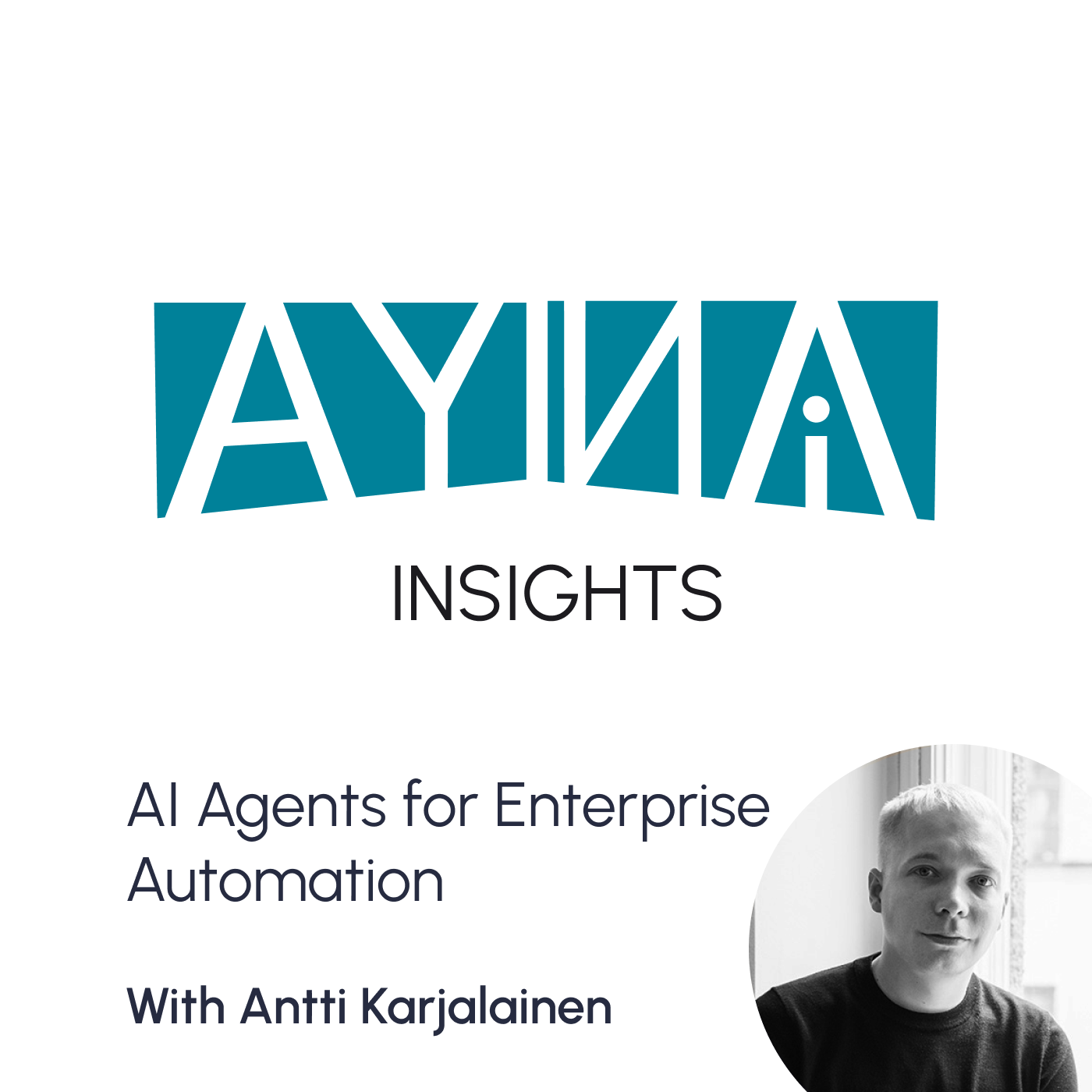Episode Transcript
[00:00:03] Speaker A: Welcome to AINA Insights, where prominent leaders and influencers shaping the industrial and industrial technology sector discuss topics that are critical for executives, boards and investors. INA Insights is brought to you by INA AI, a firm focused on working with industrial companies to make them unrivaled segment of ONE leaders. To learn more about INA AI, please visit our website at www.ina.AI.
[00:00:40] Speaker B: Welcome to INA Insights, where we explore the intersection of industrial innovation and AI. Today we are joined by Eric Udston, CEO of Twin Threads, a pioneer in industrial innovation. Former GE executive and serial entrepreneur, Eric is transforming industrial productivity through digital twins and AI. Under his leadership, Twin Threads has grown close to 400% in three years and was named to the 2024 Deloitte Technology Fast 500. Eric, it's a pleasure to have you looking forward to diving into your journey and the future of smart manufacturing.
[00:01:22] Speaker C: Pleasure to be here. Thanks for having me. Awesome.
[00:01:26] Speaker B: So, jumping straight in, what inspired you to start Twin Threads and how does it solve the challenges faced by industrial companies?
[00:01:35] Speaker C: Well, I had a unique opportunity while I was at GE to kind of experience applying analytics and AI at high scale. We worked within the energy business within GE to monitor the fleet of gas turbines. So think about 1800 power plants across the world. And I got firsthand exposure to what you could do by applying advanced analytics and AI at scale. And we were able to see significant increases in, in that case, fuel economy, productivity, as well as avoidance of major downtime events and. But it was very unique to the energy business and very unique to that type of equipment. And as we started Twin Thread, we, we saw that a similar capability would be interesting in a broader set of industries, you know, not just within energy and solving those similar problems of efficiency, productivity and uptime. Basically.
[00:02:41] Speaker B: Right. And as you put that system together, what was the setup like? I was going through the Twin Thread website and I saw this concept of the virtual operations center. Can you kind of double click, deep dive into it and describe what it does and how does it help these client companies of yours?
[00:03:03] Speaker C: Yeah, I think the great example, even going back to the. To ge, is the. There is an operations center. You know, picture a mission control room where a bunch of screens on the wall and there's a bunch of technicians that are looking after the mission, which in that case was optimize the gas turbine fleet out there, only virtualize it. Imagine now a scenario where a good engineer that's in one country can use the technology to do the same level of operations support at plants all across the world. And so that domain expertise can be force multiplied using this technology instead of having a central control room, central operations center to virtualize it and use AI and other technologies to, to make that realistic proposition.
[00:04:05] Speaker B: Got it. Interesting. So in that sense, could you kind of elaborate and share some customer success stories where twin threads came in, brought its technology and was able to transform these client operations?
[00:04:20] Speaker C: Yeah. One example I would use is it was. Is within a consumer products food and beverage manufacturer Colgate, like many companies in that space, you know, during the pandemic and even before the pandemic, experienced a major changeover in their frontline worker tenure and, and big turnover and you know, they, they make a premium product in their pet food division and they, they were looking to put in technology really to try to try to fill this skill and tenure gap with operators out on the plant floor. And what we delivered for them was a fully online quality control system that literally takes hundreds of measurements, sensor measurements off of the production process, runs it through an AI model, produces recommendations of what changes an operator should make in order to optimize their key quality parameters. And that way the operator can either use that system in copilot where they receive recommendations, the best recommendations of how to control quality, but in this case they go, they've gone fully closed loop automatic where an operator is just supervising the system and the AI is making the changes to the process to control those quality parameters to the desired targets. And they've been able to realize not only an increase in quality given really the changeover in skill set in their operating teams, but but also significant savings and material losses and other benefits from that as well.
[00:06:18] Speaker B: Oh, that's awesome. So double clicking on the copilot theme and AI a lot of companies are engaged with AI and are trying to leverage it. And especially on the industrial side. How do companies transition from this AI experimentation phase to. To a full on integration and what does twin threads do to kind of help them get there?
[00:06:45] Speaker C: First point is about industrial AI. I think it's important to understand that industrial AI is a superset of AI technologies, one of which is generative AI, obviously which is the most interest in that space. But there's also a lot of other components like the AI that perform the. The solution I just talked about earlier is, is not generative AI, it's using other AI technologies.
So it's important to understand that that first and the other thing to understand is that AI algorithm, if you want to think of it this way, is just the central core of any solution that is actually delivering value. There are many things that are wrapped around that what we say to operationalize the AI. So if we take the case I talked about, that's automatically controlling a production process even though there isn't directly AI involved with the communication of those recommendations, for example, down into an automated control system. That piece has to be there in order to fully operationalize the results. So they're, that's one example of the many things that are wrapped around the core AI technology to actually make it usable in a real production environment. And in our solutions, you know, we've worked hard to build those capabilities in and around the AI to make them usable in industrial production environment.
[00:08:25] Speaker B: In an industrial production environment, the processes, the recipes, they're all kind of secrets proprietary to the organization.
[00:08:34] Speaker C: That's right.
[00:08:35] Speaker B: In the generative AI slash non generative AI world, how does Twin Thread advise and implement its technology to help clients to protect their ip?
[00:08:47] Speaker C: That's a, that's a great question. And you know, it's, it's only, it's only been recently that we've started to see AI addendums to service agreements with clients. So it's only been in the last six months that, that they've really started to consider the implications that AI may have to some of these very critical information assets like product recipes that you mentioned.
So we deal with this in a number of ways. You know, one way is, is that this is a one way communication. You know, we don't, we're not actually pushing recommendations down into a control system. For example, they're pulled from the control system. That's one example of the firewalls, if you will, that exist that makes sure that the, the information is not flowing in the wrong direction. Then of course there is also the, the way that you use for example the generative AI technology and, and having isolated models, isolated LLMs that aren't part of the collective is another way. And then the third way is just strictly architecture.
We offer our solution as a SaaS solution that we host on customers behalf. But for those, especially enterprise customers that have high concern about some of their critical data, we actually install our solution in their, in a platform, as a service architecture within their cloud environment. Whether that be Azure or AWS or GCP as a cloud platform and that gives them custody over really the data and the security around that that typically helps to get through that hurdle of working in and around the most critical data assets that these companies have.
Got it.
[00:10:51] Speaker B: Fascinating. No, that's all great information. I would like to switch gears here a little bit and jump into your personal leadership journey and the journey that you've had in the industrial AI space. So jumping into that area, could you tell us a little bit about what sparked your interest for industrial AI and how did working in that segment shape your career and your vision?
[00:11:20] Speaker C: Yeah, interestingly enough, by training I'm a chemical engineer and started work working in the pulp and paper industry. I was fortunate enough at the time to work in a brand new greenfield construction of a plant. So we were able to choose the most modern technology to apply to this, to this plant and had ended up with tremendous results. One of the technologies that we experimented with the time were early neural network technologies. And what we applied it to at that point in time was in many ways the, the, the most elusive problem, engineering problem that would plague the paper industry, which is breaks on a paper machine. And we were able to use the technology to predict breakage on, on the paper machine and then be able to react to that to prevent downtime. And, and we went on in that particular plant to set world production records based off of, you know, the, that combined with many other technologies together. And so that was very, very early in my career and that kind of sparked my interest in these advanced analytic technologies, neural networks. And of course we didn't call it even AI at the time, but it has evolved to that. And what at the beginning of my career would have, you know, taken basically multiple full time equivalent engineers to just simply looked after the technology that has completely changed on its head today, where you can do so much more with so much less that it becomes much more feasible for that technology to be accessible to many, many more industrial companies.
[00:13:23] Speaker B: That's fascinating. And as you think about solving a problem at that particular plant, applying technology, applying the early ST of a neural net, how was the journey of taking that learning and then scaling it out and then getting into building new AI startups?
[00:13:43] Speaker C: Yeah, I mean, I think at the beginning of my career scaling wasn't even an option. It was, it, it just wasn't possible really. It, it was more bespoke solutions, you know, and that really didn't have a chance to scale. I think, you know, in my experience in the, let's say that 15 years ago, 2010 time period where we started to see companies like a GE that could afford to really build out the technology and scale it, you know, the way that we talked about early in the conversation, I really started to see the, the, the opening that this can scale. In other words, the technology, the price point, if you will, to deploy the technology is starting to come in line the skill sets. In other words, normal engineers could take this technology and use their process expertise to make progress with AI. We started to see that happen in the roughly 15 year ago time period. And then you fast forward to today. It. The things that you can do with the current state of AI technology is just exploding. And so when we have a, when the price point is right and we have an audience and a skill set, set of resources out there that can apply it to real use cases, combined with, you know, an exploding set of capabilities, it's a, it's somewhat of a perfect storm in, in the market.
[00:15:19] Speaker B: So talking of a storm, we are in a perfect storm right now. When you think about manufacturing, we are seeing the triple squeeze affect us. How does, how do you kind of navigate through those challenges?
[00:15:32] Speaker C: Well, I think companies need to think about their organization and resources differently. You know, to tying back to. Early in my career worked in a modern paper mill. We had about nine engineers that worked in that plant in various areas.
If you were to go back to that plant today, there's like two engineers that were doing what nine engineers were doing years ago.
And you know, the way things are headed is that those, those resources who previously might have applied their expertise in one plant need to apply their expertise to, to 5, 10, 20 plants and they need tools to do that. So you know, organizationally, companies need to think about, think more about applying this engineering and process talent from more of a center of excellence perspective to be able to get that scale across all of their facilities or sites and giving those, giving those individuals advanced tools to be able to do that job effectively. Because the number of resources just are not there to do the job that is needed to sort of address that triple squeeze that you mentioned. We have to go about it differently and it has to be done in a much more scalable way than had previously been done.
[00:17:05] Speaker B: Talking about doing it differently, how do you see generative AI and digital twins reshaping these industrial processes in the next few years?
[00:17:16] Speaker C: I think the early use cases around generative AI have been sort of help and work instruction and related. As if you think about in terms of the frontline worker and the manufacturing process, those are going to quickly evolve into more product development, optimal optimal recipe development, optimal product development, optimal material science that leads to new ways of manufacturing and developing products. That's right around the corners from what I see.
Awesome.
[00:17:56] Speaker B: And in terms of piggybacking on again, generative AI, how would you recommend some best practices that companies should follow as they think about adopting it and think in terms of security aspects of that.
[00:18:13] Speaker C: Yeah, I think security is the big, the big thing to consider. As I mentioned early on, you know, companies are just now considering in their services agreements the implication of AI and generative AI specifically. So it's on the radar screen, as it were. And you know, fundamentally it's security best practices is, is the table stakes, if you will, to, to proceed. And again, there's, there are contractual elements of that, but you know, above all else, there are architectural elements of that to ensure that the, that this, the system is, is secure and not leaking intellectual property. That is the, is the crown jewels of, of many of these, these companies. And then with that framework in place, I think it is, you know, when you're assured that your intellectual property is secure, then then you create the environment of experimentation. And, and we've tried with our solution to be able to.
We say it's highly scalable and what we mean is scales down just as well as it scales up.
[00:19:36] Speaker B: Right?
[00:19:36] Speaker C: So if you can do something small, prove out the unit economics of that, that builds momentum to do more and more and more. And so sort of facilitating a culture of experimentation and you know, and then scaling the things that do prove to have value is I think, a critical element of it as well. But you can't have that unless you are, you have a secure data environment and you're assured that whatever intellectual property you're developing is not leaking, you know, into the outside world.
[00:20:15] Speaker B: Eric, those are some great points and again, appreciate all the insights. All right, so that's a wrap on today's episode of INA Insights. Big thanks to Eric Udstuin for sharing his vision. Here's to a smarter, faster industrial future powered by AI. Thank you, Eric.
[00:20:33] Speaker C: Thank you.
[00:20:39] Speaker A: Thanks for listening to AINA Insights. Please visit Aina AI for more podcasts, publications and events on developments shaping the industrial and industrial technology sector.


